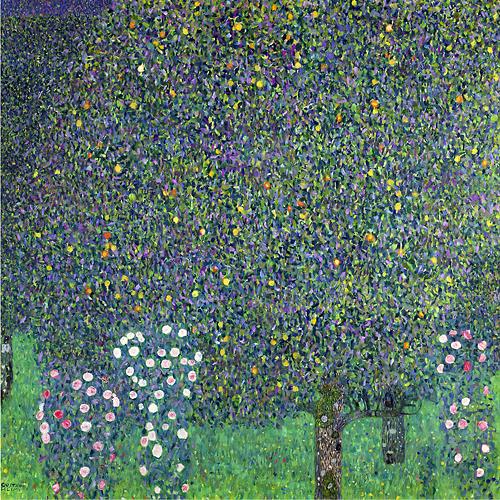Rose Bushes Under Trees - The array of colours and forms add brilliance to the painting, as luster and glare fills the canvas.
The artist behind the work, Gustav Klimt had spent his summer away in the countryside, seizing all the details in nature to reflect into his work. Most of Klimt's impressionist landscape works were produced during the artist's getaway throughout the summer between 1904 and 1905, as he travelled to Litzlberg and Lake Attersee. The canvas is covered in an array of colours and forms, accentuating the scenery into a new perspective. The artist had used small circular brush strokes within his work that to create a mosaic pattern which the artist is most prominently know for in his gold phase. A few of these classic paintings include The Kiss, Tree of Life, and Adele Bloch-Bauer.
Klimt's soft brush technique creates oval leaves, grass and fruit within the painting, showcasing his impressionist style. While the piece holds a modernist feel upon looking at the painting, the viewer is able to witness a more classic style to Klimt's landscape paintings. The small brush strokes are all strategically placed throughout the work, angling in different directions. The brush strokes add a decorative style to the work; showing the artist's classic mosaic style in the landscape piece. The dabs of colour throughout the canvas adds an abstract feel that is visually stimulating and alive.
While the artwork is focused primarily on the array of colours and forms throughout the piece, the landscape is flattened by this style. The artist depicts a meadow beneath the tree, ranging from shades of light to dark green. Small glimpse of turquoise and azure is added to the canvas to show depth within the grass. However, even with the array of colour used upon the meadow, the style of the work remains flat. The artist adds small dabs of yellow mixed with salad green to show small flowers covering the plain. Gustav Klimt's landscape painting holds a similar feel to his other work Blooming Field, Apple Tree I, and farm Garden With Crucifix. While these paintings reveal a different cooler colour scheme, the classic dabbing sponge technique remains evident through all pieces. The artist lived in Vienna, Austria throughout his career yet spend his summers in the countryside seized by nature. The new environment had inspired the artist to take up landscape drawings through a mosaic style rather than the popular realist technique at the time.
Rose Bushes Under Trees upraises a cluster of colour carefully designed through the leaves of the tree. Klimt's brush technique lightly dabbed across the canvas in different directions to create this abstract feel, however the work was placed in a mosaic style. The patchwork is a fundamentally characteristic in Klimt's style, as it will grow to incorporate gold and bronze tones within his portraits. The tree is covered in shades of green and blue as the foundation colour of the circular tree. The leaves are highlighted by a lavender coloured purple, adding a pop of colour to the turquoise colour scheme. The artist showcases light green larger specs across the leaves, showcasing pears. The structure and style of the tree is similar to Klimt's other painting, Pear Tree, showing the use of abstract colour. As the impressionist style up rose and gained popularity, the artist was most concerned with finding his own style of landscape art by taking different techniques from artists at the time. Klimt used his knowledge from French Art Nouveau painting styles, ornamental techniques and bright colours to find his own personality in the landscape era.




